Movie Review By: SFAM
Year: 1991
Directed by: Shozin Fukui
Written by: Shozin Fukui
IMDB Reference
Degree of Cyberpunk Visuals: High
Correlation to Cyberpunk Themes: Medium
Key Cast Members:
Pinocchio 964: Hage Suzuki
Himiko: Onn Chan
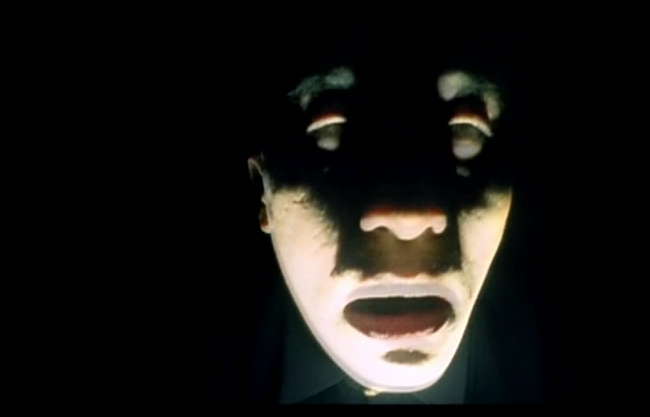
Overview: Back in 1991, Shozin Fukui and crew created a no-budget movie that provided yet another view of Japanese Cyberpunk, one very different from the first Japanese Cyberpunk movie, Tetsuo. In 964 Pinocchio, we don’t get an external merging of man and machine parts – instead, we see the residue of extreme internal struggles – ones that overwhelm the protagonists. The images are very intense, and the pacing is erratic and fast paced. While this movie is uneven and haphazard in places, 964 Pinocchio is definitely a unique experience.

The Story: In this film, 964 Pinocchio (Hage Suzuki) is a strange type of cyborg – someone that used to be human but now has been transformed into a sex slave sold as product. Unfortunately, he no longer “functions” so his owners, a pair of sex-crazed, truly bizarre and sadistic chicks, have thrown him out in the street. Simultaneously, a nurse with a mysterious past, named Himiko (played by Onn Chan), has lost her memory, and she too has been evicted to the streets.

The two outcasts meet up and seem to have a strange attraction to one another. As 964 Pinocchio is essentially a child who seems to have little understanding or awareness of the external world, Himiko takes care of him. She takes him to her living quarters in the basement of a deserted building, and takes him on a food shopping spree where they steal and eat food in the grocery store. Himiko finds out that the corporation that produced Pinocchio is feverishly looking for him, as they are afraid that their illegal process for creating sex slaves will be made public.
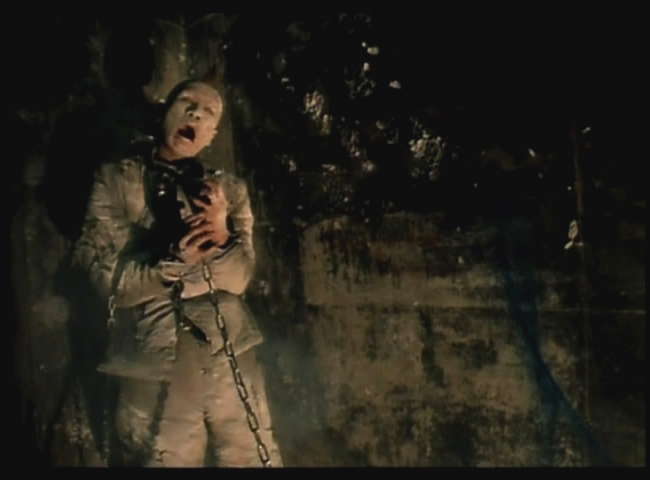
Eventually, 964 Pinocchio starts to gain awareness, and begins to wonder what has happened to him. After becoming frightened and agitated, Himiko calms him down, and then they both realize they have found a “like” soul and then make love (apparently 964 Pinocchio is able to perform when his feelings are re-engaged). Unfortunately, this event unleashes unseen forces inside of 964 Pinocchio – forces that are past the point of control. In short, all hell breaks lose – 964 Pinocchio begins spouting bodily fluids of all kinds and Himiko is thrown against the wall, and finally begins experiencing her own version of the horror. From there, the movie becomes a experiential voyage into the crazed and surreal. The corporation is still after 964 Pinocchio, but they soon discover he is not the same as he once was.

Rubber’s Lover is the Prequel to 964 Pinocchio: Even though it was created 5 years later, Fukia’s Rubber’s Lover is a sequel of sorts to 964 Pinocchio. In this film, we never really understand the process for how Pinocchio was created. Rubber’s Lover gives us a view of this. While the cover for the DVD describes 964 Pinocchio as an android, he’s really not. In fact, he’s virtually all human (although there is a drill to the forehead scene that shows brain matter being removed). If Rubber’s Lover is any guide, he was created by intense sound waves and special chemicals. So at one point he “was” human, but now is “post-human.”
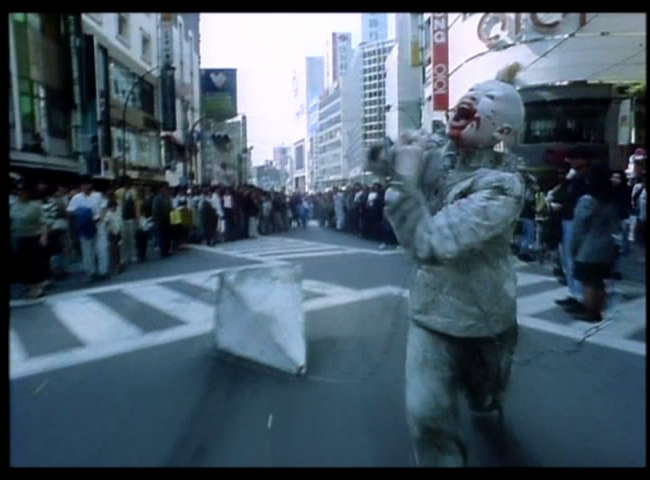
Note to Low Budget Japanese Cyberpunk Film Makers – Use B&W: Because of the low to no budget nature of 964 Pinocchio, the FX are not top quality. While they probably worked better prior to the CG world that we have today, similar to Videodrome, they look very dated in places now. This takes away from the impact of the movie to the point that it just doesn’t really work now unless you put it on a big screen and really crank up the sound. In comparing Tsukamoto’s Tetsuo (a B&W movie) to Tetsuo II: Bodyhammer (a color movie) and Fukui’s Rubber’s Lover (a B&W movie) to 964 Pinocchio, it’s clear that the mood, visuals and ambiance required for Japanese Cyberpunk is FAR better provided by B&W over color. In addition to both Tetsuo and Rubber’s Lover being better movies, they are both FAR more immersive. The low-budget B&W effects don’t detract from the mood, whereas in comparison the color effects look very fake. As an added benefit, shooting in B&W gives the film maker the a critical tool for cyberpunk mood setting: shadows. The use of shadows in a B&W film serve to create a dark, noir feeling which automatically serves up a non-normal mood.
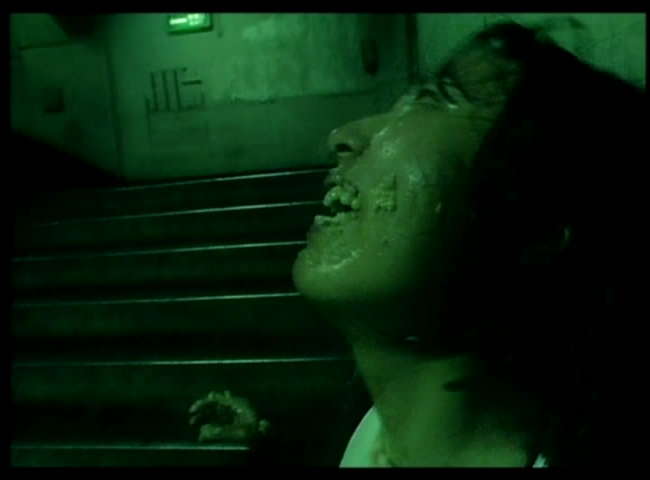
If You Have Vomit Fetish, 964 Pinocchio is For You! Fukui CLEARLY has a vomit fetish, and decides to share it with us in 964 Pinocchio. We’re not talking a wee bit’O vomit coming out - we’re talkin GALLONS worth! Himiko in particular vomits, wipes it on herself, wallows in it, and then eats it all back up! Yummy!
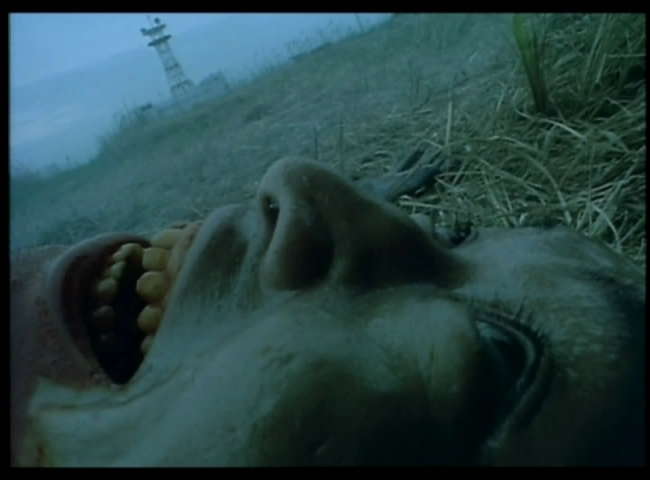
The Bottom Line: 964 Pinocchio is not polished fare, but it does etch out a place in the history of cyberpunk. The story is rather basic, and is really beside the point (many are left confused at the ending – page 2 gives a spoiler understanding if interested). The purpose is to create an immersive mood that details what happens when a dominant power emerges and exceeds human physical capacities. 964 Pinocchio is not for everyone – in fact it’s for a select few. If you aren’t a fan of extreme horror, gruesome imagery, constant screaming, jagged camera work and intense emotions, this movie is probably not for you. If you just want to see a Fukui film, you’re probably better off picking Rubber’s Lover. But if you want an instance of Japanese Cyberpunk in color – the first one in fact – 964 Pinocchio merits a watch.
Page 2: More Intense Screencaps and Spoiler Understanding of the Ending–>
~See movies similar to this one~
In yet another “as strange as fiction” story, scientists are experimenting with a process that grows meat in an incubator. Similar to a breadmaker, the idea is you give your new “Ronco Meat Maker” a few cells of whatever tasty dead animal you’re interested in growing (perhaps a few pre-chewed bites of a really tasty hamburger you didn’t finish), then add whatever the meat equivalent of yeast is - close the lid and presto! A short while later, you have a large hunk of “pre-dead” animal just waiting to be consumed!
Instead of being cut from a farm animal, the beef, pork or chicken would be grown in incubators from a few starter cells, a growth medium and some hormones to get the cells to divide.
The first attempts by scientists who grow animal muscle tissue in the lab have been small in scale. But researchers are looking forward to the day when meat could be cultivated in industrial bioreactors or even in a device sitting on a kitchen counter…
…He said a device similar to a bread maker could one day be used to manufacture meat in the home.
Matheny said muscle produced in an incubator could have reduced fat content, and the process would do away with problems such as bacterial contamination and mad cow disease.
Call me crazed, but this seems to have all sorts of bizarre uses. Does this mean that in the future, when someone says, “eat me, asshole!”, you’re supposed to scrape off a few skin cells and put them in your Ronco Meat Maker machine? If so, what’s the comeback line supposed to be - “Will you supply katsup with that?”
In any event, it looks like the best this thing can do is create pre-processed meat items, so don’t expect a T-Bone steak out of the deal. And apparently, growing meat in an incubator leaves something to be desired in terms of taste - early tests show that grown frog muscle tissue tastes like “Jelly on a cloth.” Yum!
This post has been filed under Cyberpunked living by SFAM.
Movie Review By: SFAM
Year: 1982
Directed by: Aaron Lipstadt
Written by: Don Keith Opper, James & Will Reigle
IMDB Reference
Degree of Cyberpunk Visuals: Low
Correlation to Cyberpunk Themes: Medium
Key Cast Members:
Max 404: Don Keith Opper
Dr. Daniel: Klaus Kinski
Maggie: Brie Howard
Cassandra: Kendra Kirchner
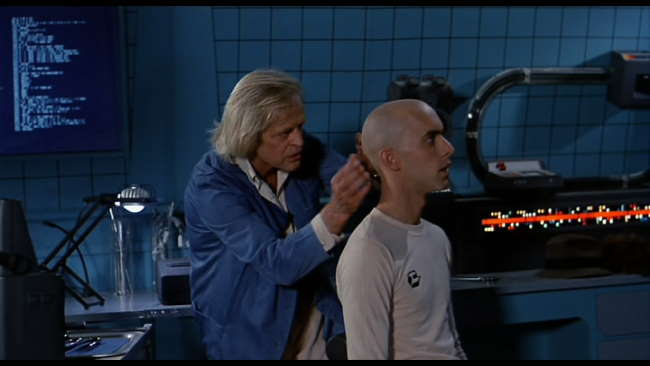
Overview: There are some really good Sci-Fi movies that I don’t consider strictly cyberpunk, but still are strong enough in some ways that I feel compelled to include here. Android is one of those films. Android, in a very low-budget manner, gives us a wonderful exploration of androids and their early attempts to assimilate with humankind. On top of this, the writing is interesting and the acting is very good, especially Klaus Kinski and Don Keith Opper. The budget is low enough that the FX and set designs actually do detract some from the enjoyment of the film, but not enough to stop you from seeing this.
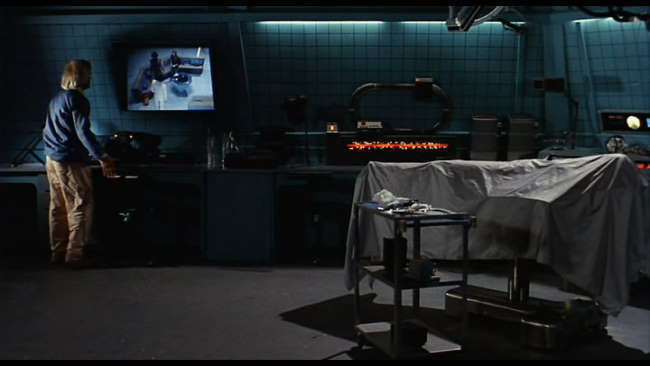
The Story: Android takes place on a large but deserted research-oriented space station located in deep space. Dr. Daniel (played wonderfully by Klaus Kinski), a genius by unstable scientist has almost completed his greatest creation – a perfect female android, named Cassandra. Apparently, Androids have been outlawed on Earth, due to some catastrophic event that occurred previously (hence, the reason for the deep space station), so Dr. Daniel must continue his work under cover with only minimal assistance. His current assistant, Max 404 (Don Keith Opper – also the writer) is also an android, but he is but a prototype – an imperfect experiment may no longer be necessary to continue. Unfortunately, Dr. Daniel needs a living female to “give Cassandra life” by transferring some of her essence to Cassandra.
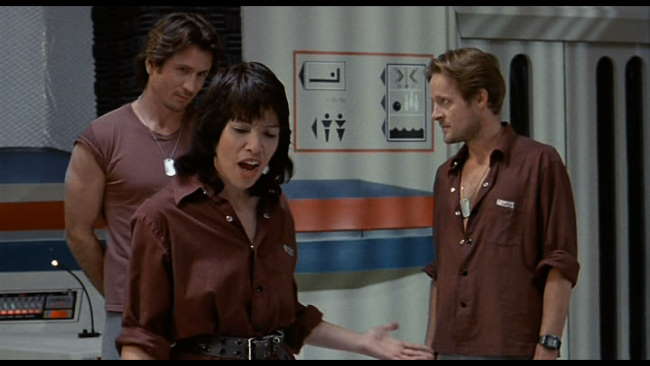
Providence strikes when an outlaw group of criminals on a run-away space ship ends up in their quadrant with a ship in need of repair. As they dock, the criminals, two men and a woman, happily greet Dr. Daniel and Max, and begin looking for what’s valuable to steal, while Dr. Daniels sees this as his golden opportunity to get a woman to finalize his android. Max 404 is immediately attracted to Maggie (Brie Howard), the female convict. At the prompting of the other convicts, Maggie humors Max 404 in order to find out more information. Things come to a head when Max 404 overhears Dr. Daniel say that Max will be deactivated when Cassandra comes online. Max decides his only chance for life is to leave with the convicts, and decides to take things into his own hands.
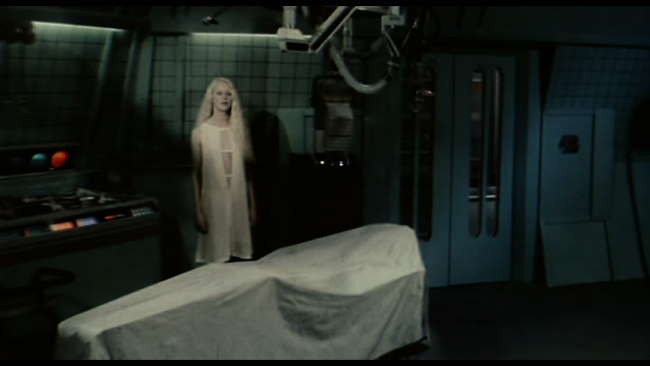
Metropolis’ Maria Recreated: Android employs some fun linkages between previous movies. Max 404 tends to enjoy old B&W, and tends to watch ones that foreshadow coming plot scenes. One of the cool scenes in this movie was when Max 404 is watching the movie Metropolis on the computer monitor. The scene where the evil scientist, C.A. Rotwang is creating an evil android version of Maria from the human Maria. In Android, Dr. Daniel needs to capture Maggie to use her essence to “give life” to the perfect android, Cassandra. The parallels are obvious, and are appreciated to anyone familiar with Metropolis. In another scene, Max 404 is watching “It’s a Wonderful Life” where Stewart finally gets up the urge to go see Mary at her house – this occurs right before Max 404 has his love scene with Maggie.
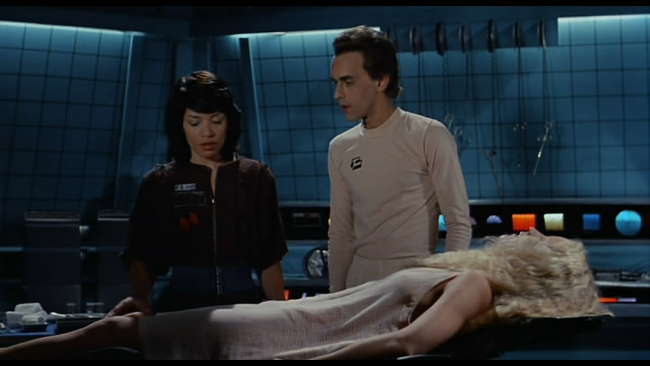
Android Coming of Age Story: One of the really interesting things about Android is Max 404, only 5 years old, engaging in a coming of age type story. Max has the ability to think and feel, but has never experienced anything outside the boundaries of the space station. He spends his time dreaming of Earth, playing video games, and imaging himself engaging in interesting life experiences. He’s not human, but unfortunately for Max, this is the only model he has in determining how to act and react to new situations. Maggie provides him his first opportunity to “engage” in a way that he’s always wished. As soon has things come to a head, Max’s choices are markedly different than a human might be. Max doesn’t feel guilt, nor does he worry about human taboos such as murder, etc. But the highlight of the movie is Don Keith Opper’s acting when he thinks Dr. Daniel (Kinski) is going to deactivate him – this alone is almost worth watching the movie for.
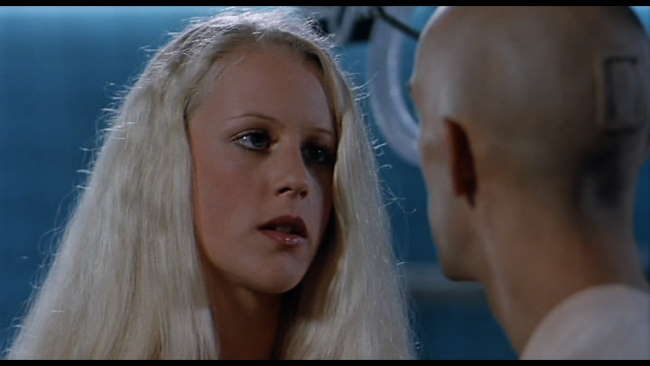
Notice the control panel on the back of Max 404’s head.
The FX: The FX in Android is extremely low-budget. In listening to the commentary, we find out that the story was written as a way to gain additional monetary benefit out of an existing space station set. Android never veers into Dr. Who FX territory, but there are a number of cheesy looking elements that do detract somewhat from the mood. The ships that come to dock have a decidedly Saturday morning kids show look, and the guest suites look very 70s with the off-color strips going around the wall. Still, for the most part things generally work.
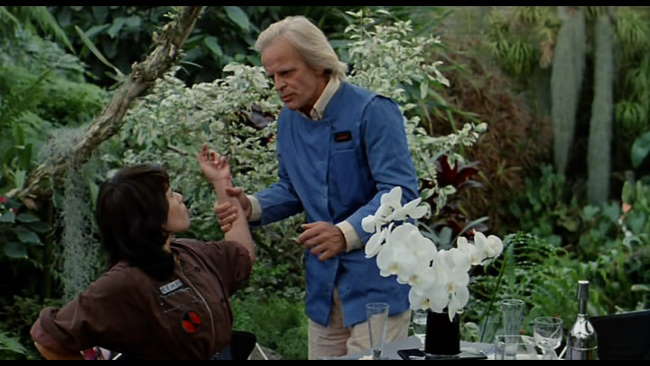
The Bottom Line: Android is one of the really well made low-budget Sci-Fi movies of the 80s. The FX aren’t great, (except for one cool scene that’s a spoiler – DON’T CLICK on this unless you’ve seen the movie - spoiler “decent FX” shot), but the story more than makes up for it. Android gives us a pretty interesting view of a young, imperfect android, engaging in the “coming of age” story, and dealing with challenges far different than perhaps a human might. The ending is also interesting, when Cassandra finally awakes – she too acts differently than expected. In short, Android is a very well written, well acted, and interesting low-budget Android flick.
~See movies similar to this one~
Movie Review By: SFAM
Year: 2002
Directed by: Terry Cunningham
Written by: Flavia Carrozzi, Terry Cunningham & Steve Latshaw
IMDB Reference
Degree of Cyberpunk Visuals: Low
Correlation to Cyberpunk Themes: Medium
Key Cast Members:
Nick ‘Jester’ Chase: Nick Cornish
Neville: Adrian Paul
Skylar: Bai Ling
Tess Woodward: Vanessa Marcil
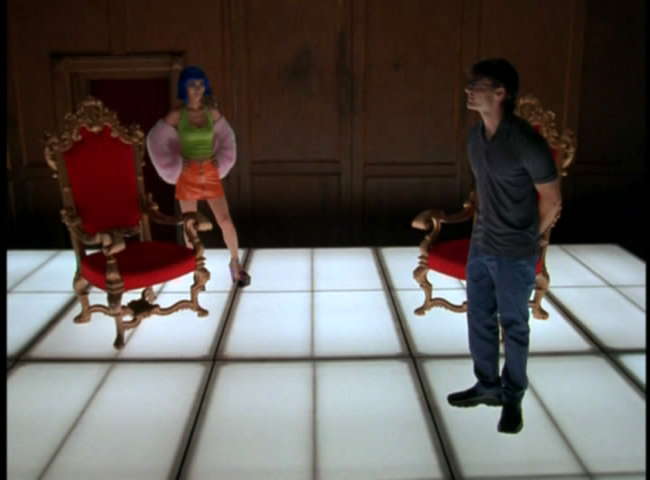
Overview: Overview: Codehunter (a.k.a. Storm Watch) is a fun, but absurd low budget AI and VR flick. This is not a movie who’s technical plot holds together, but it does work as a bubble-gum current-setting hacker-cyberpunk romp. Code Hunter is another War Games-Hacker-Colossus, the Forbin Project rip-off, but in a simplistic and enjoyable way. I’m a sucker for movies with either Bai Ling and Adrian Paul in it. Along with those two, the supporting cast which includes Babylon Five’s Jerry Doyle, Vanessa Marcil and Nora Dunn is pretty fun too.
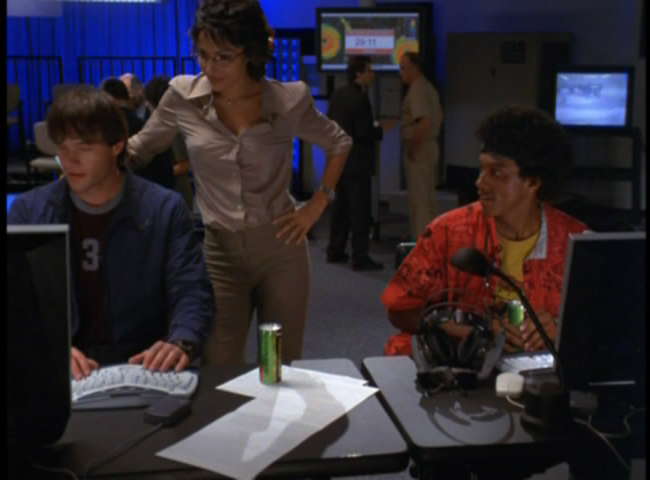
The Story: Nick “Jester” Chase (played by Nick Cornish) is a reformed hacker who likes to hang out in a VR first person shooter game called Shock. Simultaneously, a small computer firm is attempting to sell the US Navy on a new satellite system called “Thunderhead,” which is designed to control the weather. Nick is contacted in the game by Skylar (Bai Ling), a computer genius extraordinaire, to steal a file from an unknown computer system. After refusing, Skylar blackmails Nick by modifying his record to make him a wanted fugitive. Skylar agrees to steal the file, but then hides it and tries to go to the news station to seek protection. He enlists the aid of up and coming reporter, Tess Woodward (Vanessa Marcil), who agrees to help him.
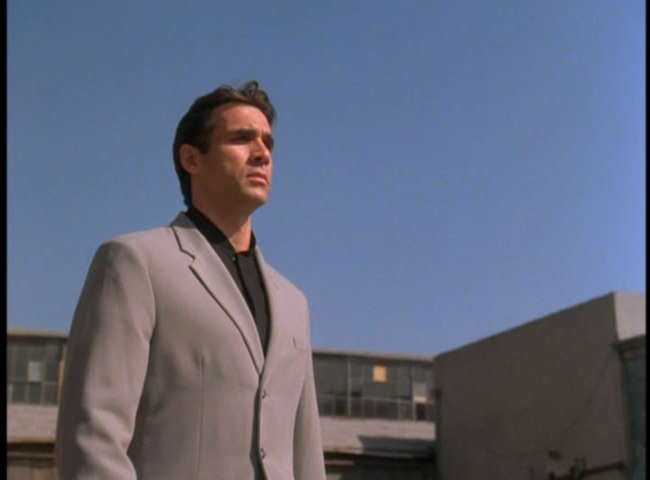
Unfortunately, Thunderhead appears to be out of control, and has created two massive hurricanes on each side of the US that will devastate the both coasts, causing potentially millions of deaths and billions in damages. The government tracks down Nick and bring him in for questioning. As the plot unfolds, it appears that a strange connection between the VR game “Shock” and Thunderhead emerges. Unless they can unravel it, the consequences will be catastrophic.

The Bottom Line: Although the cast is fun, and the pacing is good, the actual plot points and coherency are well past the point of believability. They are too numerous to count, but suffice to say the good guys had a number of obvious solutions that could have stopped the catastrophe. To add insult to injury, the movie overstretches its AI angle – had it stopped earlier, it would have worked within the narrative, but instead, they go for the sappy “teach me all of humanity” angle. Again, the movie is fun to watch, but lacks any real intelligence.
~See movies similar to this one~
The Mundane-SF blog found a cool article that provides the results of new research into connecting neurons with silicon chips. The article titled “Researchers get neurons and silicon talking” posted on Physorg.com states the key finding as follows:
European researchers have created an interface between mammalian neurons and silicon chips. The development is a crucial first step in the development of advanced technologies that combine silicon circuits with a mammal’s nervous system…The ultimate applications are potentially limitless. In the long term it will possibly enable the creation of very sophisticated neural prostheses to combat neurological disorders. What’s more, it could allow the creation of organic computers that use living neurons as their CPU…
While the prosthesis aspects sound pretty similar to Kevin Warwick’s I, Cyborg project, the organic computer stuff is straight out of a post-human, cyberpunk future. Similar to how the cyborgs in Ghost in the Shell have access to vast amounds of data via a computer brain link, this technology holds extreme potential for changing society.
This post has been filed under News as Cyberpunk by SFAM.
Movie Review By: SFAM
Year: 1993
Directed by: Sumiyoshi Furakawa
Written by: Yasushi Hirano (story), Kazumasa Hirai & Jirô Kuwata (characters)
IMDB Reference
Degree of Cyberpunk Visuals: Low
Correlation to Cyberpunk Themes: High
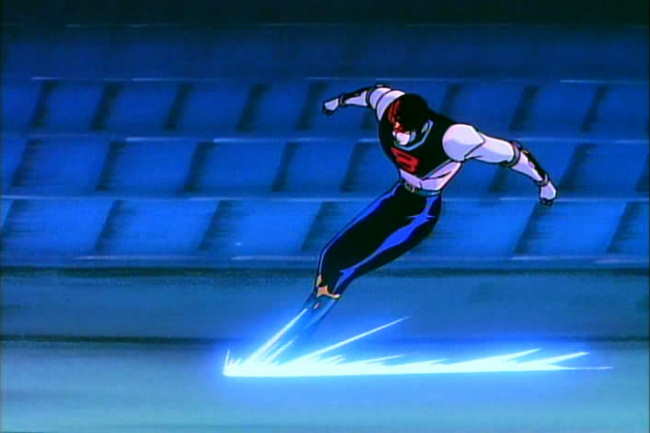
Overview: If you’re hankering for a sequel to Robocop, skip the live action sequels, and instead get 8 Man After. You won’t get the best animation, but the story itself is more than passable. The characters aren’t all that deep, but they’re interesting enough to keep your attention. This OVA, which on the DVD is presented as a film, seems to rise above the obviously meager animation budget to produce a decent product.
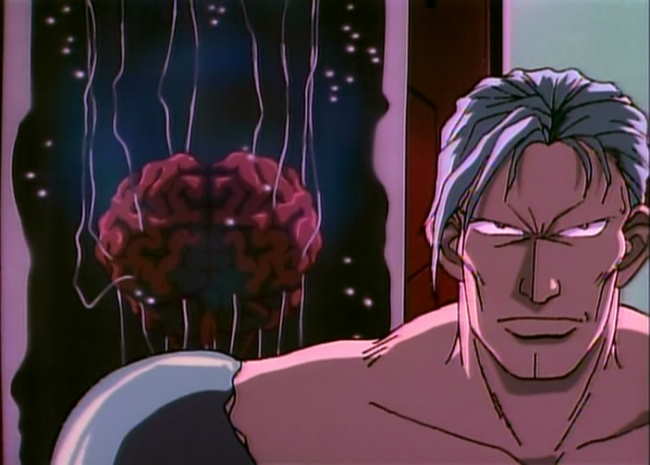
The Story: 8 Man After is a sequel to the 1960s TV series called 8th Man (I have not seen the original). In 8th Man, a cop dies, is revived, and is given a cybernetic body that can move lightning fast. He uses it to confront a cyborgs crime lord in similar circumstances, but is later killed. His girlfriend, Sachiko Yokogawa, never learns what happens to him. Since then, petty criminals with cybernetic implants have started to rule the streets. The police are outgunned, and decide they need a special edge – so they decide to revive the 8 Man.

In 8 Man After, a similar situation occurs as in the original – this time, police detective Hazama Itsuro, an emotionally fragile cop, meets up with Sachiko on a chance encounter, and they begin to fall in love. But fate intervenes, and a nasty criminal with cyborgs implants comes to kill them. Hazama is able to defeat him, but seemingly dies in the process by falling out of a high story window. Hazama is revived when the police take Hazama’s brain and insert it into 8 Man’s body.
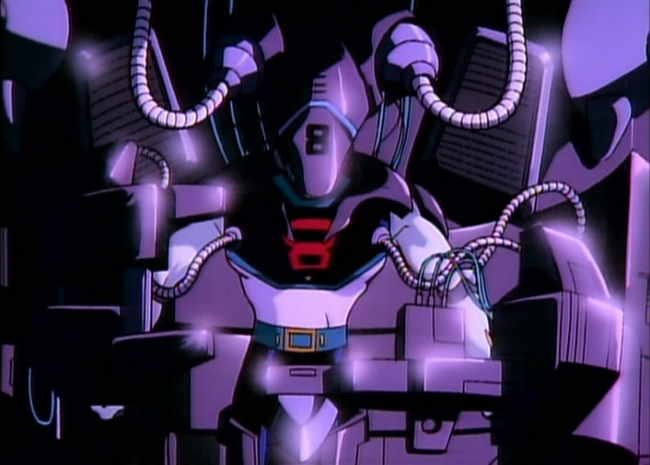
Hazama can now move lightning fast, and due to technical reasons, is the most advanced cyborgs on earth. He begins to fight the bad guys, but unfortunately, it turns out that his emotional troubles cause him to occasionally lose control over his actions. This is complicated by Hazama’s continuing relationship with Sachiko, who does not know what he’s become. Things come to a head when Hazama/8 Man goes up against the crime lord while trying to rescue Sachiko.
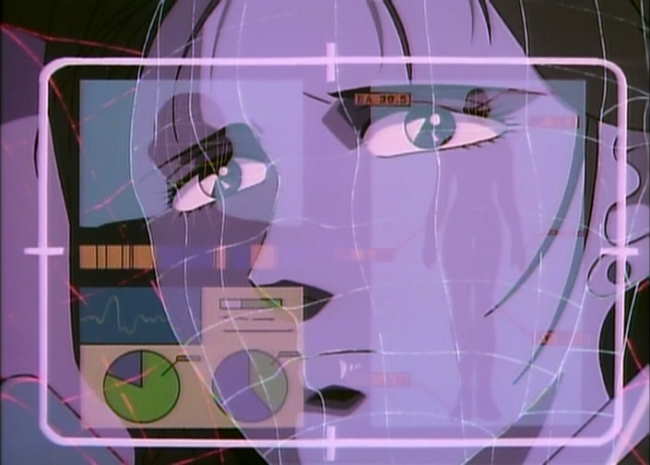
This is a “Who am I?” Story: 8 Man After does a decent job of going over established ground in that it questions whether a brain inserted into a cyborgs host is still human. The complicating twist in 8 Man’s case is that his emotions end up making him temporarily lose control over his body, and in fact, lose awareness over certain events. The added relationship aspect, where Sachiko has now fallen in love with two people who end up losing their bodies is sort of interesting as well. Again, there’s nothing really new here, but it is well done.
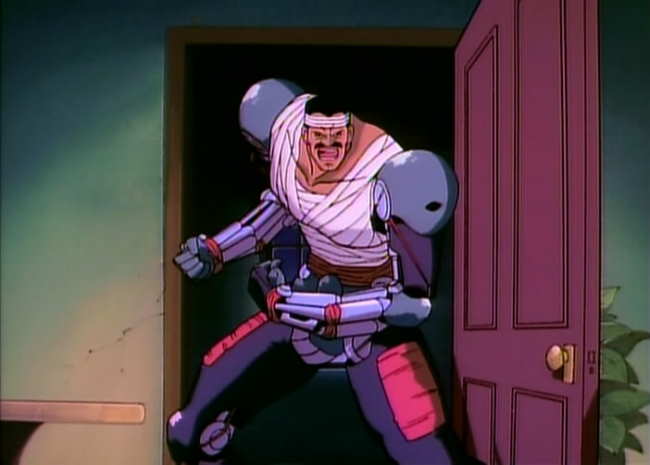
The Animation: At some level, animation of this quality, five years after Akira is surprising. Many of the shots look like straight Saturday morning cartoon fodder. Every now and then, we get a terrific shot or two, and sometimes get an innovating looking camera approach, but for the most part, you get simplistic backgrounds, very basic character designs, linear movement, and lots of pan and scans of stills. Worse, you also get some repeated 8 Man after streaking shots. Without an absolutely kickin story (which it has), 8 Man After just wouldn’t be worth the time.

The Violence: Like Robocop, 8 Man After is very violent. However, the animation isn’t good enough for this to really matter all that much. There is lots of blood and killing which is usually don’t in the context of a motivating story, but it just doesn’t have the impact of many violent animes. Even if you can’t stomach violent story lines, you will probably be OK with 8 Man After.
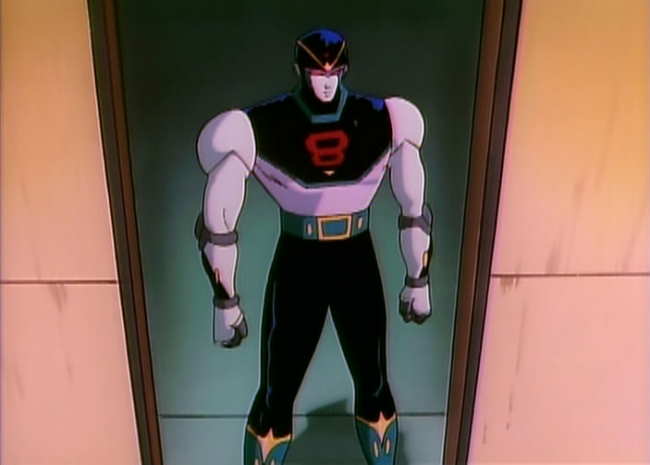
The Bottom Line: OK, the animation isn’t the greatest, but the story is pretty good – FAR better than the Robocop sequels. The sub-plot of the son with a burnt-out cyborg father is especially well done. If you’re looking for a Robocop-like examination of humanity, animated from the cyborg’s perspective, 8 Man After is a decent choice.
~See movies similar to this one~
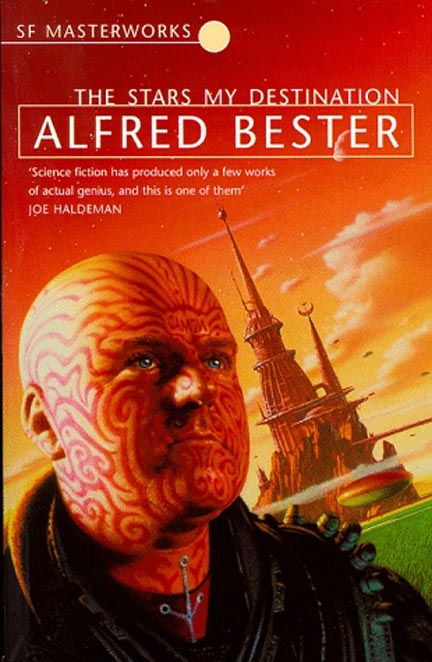
Alfred Bester’s The Stars My Destination is definitely one of the best Sci-Fi books of the 50s, and is as close as you could get to cyberpunk. Gully Foyle is one of the all time interesting characters, and Bester’s “Jaunting” is certainly the best visionary use of teleportation that I’ve read. By most accounts, this book influenced later cyberpunk authors.
However, like any great work, it is with trepidation that I am reminded of all the travesties of literary works poorly transformed on screen that forces me to temper my excitement for a potential movie. Variety is reporting that Universal Pictures has obtained rights to Bester’s seminal work, and that Lorenzo di Bonaventura, producer of Constantine and Doom, is going to be producing this along with Raymond Wagner. Hopefully they pick a good director and really adhere to the source material. The Stars My Destination is unique in that time hasn’t past it by - the story still works as well today as it did then.
This post has been filed under Upcoming Movies by SFAM.

Prosthetic linbs have really come a long way. Now we have instances of people controlling fully integrated artificial limbs with their regular nervous system.
His arms were amputated. Jesse woke from a monthlong coma to discover his limbs gone, his life changed…Dr. Kuiken explained to me that, shortly after the accident, Jesse underwent surgery, and was essentially rewired. Live nerves that control arm and hand movements — nerves that were severed — were re-directed to Jesse’s pectoral muscles in his chest. Electrodes were then attached to the chest, and connected to the robotic arm.
For 59-year-old Jesse Sullivan, who lives in Dayton, Tennessee, it’s all part of everyday life in. Jesse is a bionic man. Think science fiction…Jesse’s brain now thinks that when his pectoral muscles move, his arm, wrist and elbow are moving. When Dr. Kuiken touches points on his chest, Jesse feels as if the doctor is touching his thumb, or the palm of his hand.
The dawning of the cyborg has arrived. Currently, we only envision replacing lost limbs. At some point when this becomes commonplace, we will most likely begin to envision radically different forms of body modification.
This post has been filed under Cyberpunked living, News as Cyberpunk by SFAM.

Anime News Network is reporting that the next installment in the Production IG’s GITS: SAC world will be a movie entitled, Ghost in the Shell: Stand Alone Complex - Solid State Society:
Ghost in the Shell: Stand Alone Complex Solid State Society, a full length movie based on Ghost in the Shell Stand Alone Complex is currently planned for completion in the summer of 2006.
The production announcement does not specifically state release format, or date. The movie is being produced in Hi-Vision, a format used by Japanese broadcast networks to support wide-screen televisions. The same production team, including main staff, will be carried over from the TV series. The budget, while not specified, is said to be higher in order to achieve a cinematic level of production.
The 100-minute (tentative running time) movie takes place in 2034, two years after the refugee riot incident. A significantly larger Section 9, with over 20 new officers, investigates terrorist actions related to a wizard-like hacker “Kugutsu Mawashi.”
(Kugutsu Mawashi translated into English is roughly “Puppet Master.” Kugutsu Mawashi is not the same as the “Puppet Master” from the first Ghost in the Shell Movie. In Japanese, the “Puppet Master” from the first movie was called “Ningyo Tsukai” which can also translated into “Puppet Master.”)
The production committee will comprise Production I.G., along with Bandai Visual, Bandai Entertainment, Dentsu Corporation, Nihon TV Broadcasting (NTV), Manga Entertainment, Tokuma Publishing, and Victor Entertainment.
GITS SAC is definitely one of the best animes out right now (review forthcoming), with the second season being better than the first (should I review the two seasons separately?). The transition of GITS: SAC to a movie format will be interesting.
This post has been filed under Upcoming Movies by SFAM.
Movie Review By: SFAM
Year: 1990
Directed by: Irvin Kershner
Written by: Frank Miller & Walon Green (screenplay), Michael Miner & Edward Neumeier (characters)
IMDB Reference
Degree of Cyberpunk Visuals: Medium
Correlation to Cyberpunk Themes: Low
Key Cast Members:
Robocop: Peter Weller
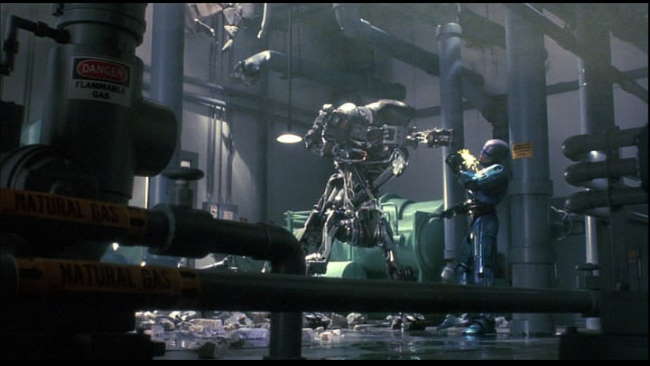
Overview: Oh how the mighty have fallen. In Robocop, we get a violent, satirical look at a future with an interesting story, complete with cyborg musings and incredible visuals. In Robocop 2, we get a tripe, over-the-top monstrosity that devolves into a Godzilla versus King Kong movie. Where Robocop provided a biting commentary on the state of corporate influence and advertising, Robocop 2 settles for a simplistically evil, nonsensical, corporate stooges who are far more interested in screwing society than they are making long term profit. Put simply, Robocop 2 is a mess when compared to its original.
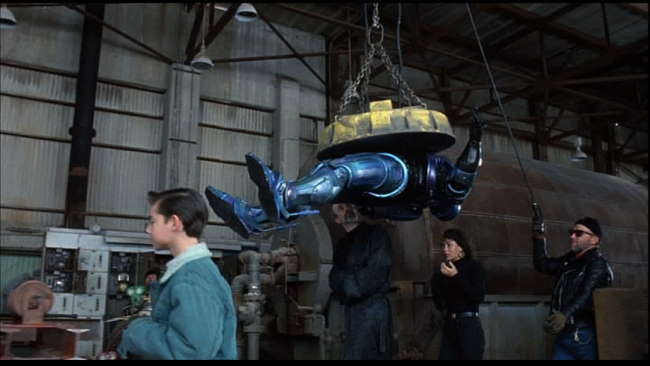
The Story: In Robocop 2, the OCP Corporation is bent on nefariously taking over ownership of the city so that it can squeeze every dollar out of the populace (which, interestingly, is already poor). As part of their plan, OCP tacitly supports the distribution of a new addictive drug called “Nuke.” With the cops on strike and the evil drug lord Cain distributing the drug and destroying the populace, only Robocop is there to protect Detroit from complete anarchy. But even Robocop is removed when a new scheming corporate businesswoman at OCP will do anything to get to the top, including screwing the CEO, ruining Robocop and replacing him with the Nuke drug lord, Cain. I could to into more details, but truly, the plot sucks too much to bother.
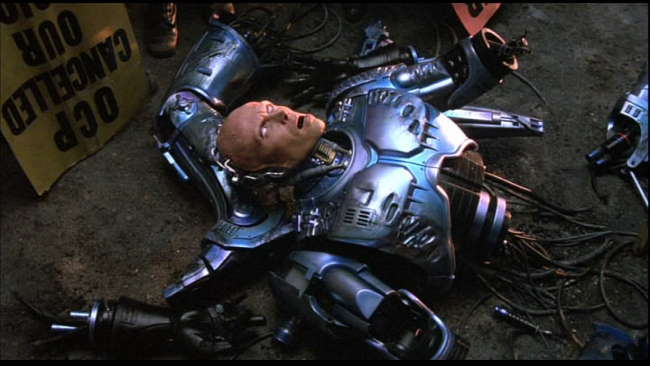
Robocop Stripped: “Christ, he’s been stripped,” is the line the policeman delivers upon seeing Robocop as a heap of parts. I couldn’t agree more. The plot points in Robocop 2 are idiotic at best. OK, so the bad guy and his 12 year-old kid beat Robocop. Of course, the logical thing to do is to drop him off, living parts and all at police HQ, right? And of course it makes sense for a Lawyer to control the Robocop project, even though there aren’t any legal issues involved. And just as logical is the corporation that gambles its entire viability on a psycho-maniac dead drug addict to be its corporate face and protector of the public, while destroying its investment in Robocop by programming him with silly parables (Gee, any reason they didn’t just re-assign Robocop to the military?). In topping this silliness, at least we know that Robocop, human brain and all, is able to easily withstand a drop from the top of a skyscraper. Interestingly, Robocop 2 tells us that the most expensive part of running a city is the police department, not the building of an ENTIRE NEW DOWNTOWN, which, we are told, will instantly pay for itself because its population will be paying for an addictive drug! I could go on, but clearly, the plot isn’t supposed to make sense. One wonders what the original script looked like as its pretty clear that Frank Miller’s script was modified significantly.
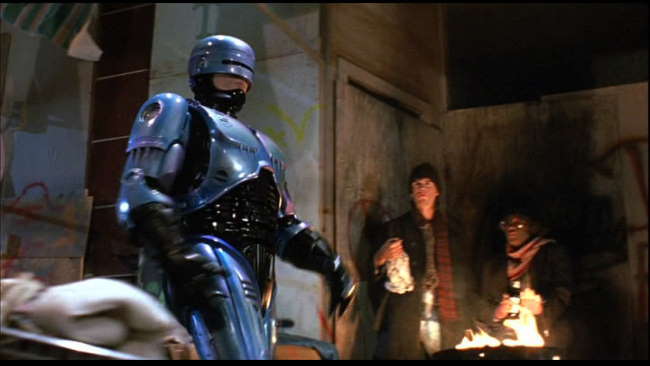
You can tell why OCP wants to steal Detriot to make money of the populace.
Detriot’s citizens are all millionaires!
The Bottom Line: While most of the key characters return (Peter Weller, Nancy Allen, Dan O’Herlihy, Felton Perry), they are joined by a cast that includes a parodied lunatic for a mayor (Willard Pugh), a kid for a bad guy (always the touch of death), and shallow scheming, horrible acting corporate bitch (Belinda Bauer). The interesting questions from the first movie are again posed, but this time in a sophomoric, absurd fashion – so much so that they divorce any interest in the potential answers. The FX, including the stop-motion animation are still decent enough to keep the movie from being a total waste, but just barely. If Robocop was intended as a total goof (meaning the actors realized this), it would have worked better. Instead, we get a story that qualifies as a parody while the actors seem to think they’re making a credible remake. The result is less than stellar.
~See movies similar to this one~
WordPress database error: [You have an error in your SQL syntax; check the manual that corresponds to your MySQL server version for the right syntax to use near '' at line 1]
SELECT COUNT(ID) FROM
|






































